Algal bloom

An algal bloom or algae bloom is a rapid increase or accumulation in the population of algae in freshwater or marine water systems. It is often recognized by the discoloration in the water from the algae's pigments.[2] The term algae encompasses many types of aquatic photosynthetic organisms, both macroscopic multicellular organisms like seaweed and microscopic unicellular organisms like cyanobacteria.[3] Algal bloom commonly refers to the rapid growth of microscopic unicellular algae, not macroscopic algae. An example of a macroscopic algal bloom is a kelp forest.[3]
Algal blooms are the result of a nutrient, like nitrogen or phosphorus from various sources (for example fertilizer runoff or other forms of nutrient pollution), entering the aquatic system and causing excessive growth of algae. An algal bloom affects the whole ecosystem.
Consequences range from the benign feeding of higher trophic levels to more harmful effects like blocking sunlight from reaching other organisms, causing a depletion of oxygen levels in the water, and, depending on the organism, secreting toxins into the water. Blooms that can injure animals or the ecology, especially those blooms where toxins are secreted by the algae, are usually called "harmful algal blooms" (HAB), and can lead to fish die-offs, cities cutting off water to residents, or states having to close fisheries. The process of the oversupply of nutrients leading to algae growth and oxygen depletion is called eutrophication.
Bloom characterization
| Part of a series on |
| Plankton |
|---|
 |
The term algal bloom is defined inconsistently depending on the scientific field and can range from a "minibloom"[when defined as?] of harmless algae to a large, harmful bloom event.[4] Since algae is a broad term including organisms of widely varying sizes, growth rates, and nutrient requirements, there is no officially recognized threshold level as to what is defined as a bloom. Because there is no scientific consensus, blooms can be characterized and quantified in several ways: measurements of new algal biomass, the concentration of photosynthetic pigment, quantification of the bloom's negative effect, or relative concentration of the algae compared to the rest of the microbial community.[4] For example, definitions of blooms have included when the concentration of chlorophyll exceeds 100 ug/L,[5] when the concentration of chlorophyll exceeds 5 ug/L,[6] when the species considered to be blooming exceeds concentrations of 1000 cells/mL,[7] and when the algae species concentration simply deviates from its normal growth.[8][9]
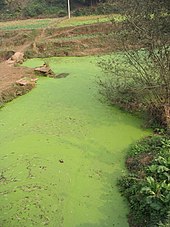
Blooms are the result of a nutrient needed by the particular algae being introduced to the local aquatic system. This growth-limiting nutrient is typically nitrogen or phosphorus, but can also be iron, vitamins, or amino acids.[3] There are several mechanisms for the addition of these nutrients in water. In the open ocean and along coastlines, upwelling from both winds and topographical ocean floor features can draw nutrients to the photic, or sunlit zone of the ocean.[10] Along coastal regions and in freshwater systems, agricultural, city, and sewage runoff can cause algal blooms.[11]
Algal blooms, especially large algal bloom events, can reduce the transparency of the water and can discolor the water.[3] The photosynthetic pigments in the algal cells, like chlorophyll and photoprotective pigments, determine the color of the algal bloom. Depending on the organism, its pigments, and the depth in the water column, algal blooms can be green, red, brown, golden, and purple.[3] Bright green blooms in freshwater systems are frequently a result of cyanobacteria (colloquially known as "blue-green algae") such as Microcystis.[3][12] Blooms may also consist of macroalgal (non-phytoplanktonic) species. These blooms are recognizable by large blades of algae that may wash up onto the shoreline.[13]
Once the nutrient is present in the water, the algae begin to grow at a much faster rate than usual. In a mini bloom, this fast growth benefits the whole ecosystem by providing food and nutrients for other organisms.[9]
Of particular note are the harmful algal blooms (HABs), which are algal bloom events involving toxic or otherwise harmful phytoplankton. Many species can cause harmful algal blooms. For example, Gymnodinium nagasakiense can cause harmful red tides, dinoflagellates Gonyaulax polygramma can cause oxygen depletion and result in large fish kills, cyanobacteria Microcystis aeruginosa can make poisonous toxins, and diatom Chaetoceros convolutus can damage fish gills.[14]
Freshwater algal blooms
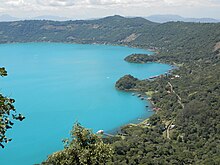
Freshwater algal blooms are the result of an excess of nutrients, particularly some phosphates.[15][16] Excess nutrients may originate from fertilizers that are applied to land for agricultural or recreational purposes and may also originate from household cleaning products containing phosphorus.[17]
The reduction of phosphorus inputs is required to mitigate blooms that contain cyanobacteria.[18] In lakes that are stratified in the summer, autumn turnover can release substantial quantities of bio-available phosphorus potentially triggering algal blooms as soon as sufficient photosynthetic light is available.[19] Excess nutrients can enter watersheds through water runoff.[20] Excess carbon and nitrogen have also been suspected as causes. Presence of residual sodium carbonate acts as catalyst for the algae to bloom by providing dissolved carbon dioxide for enhanced photosynthesis in the presence of nutrients.
When phosphates are introduced into water systems, higher concentrations cause increased growth of algae and plants. Algae tend to grow very quickly under high nutrient availability, but each alga is short-lived, and the result is a high concentration of dead organic matter which starts to decompose. Natural decomposers present in the water begin decomposing the dead algae, consuming dissolved oxygen present in the water during the process. This can result in a sharp decrease in available dissolved oxygen for other aquatic life. Without sufficient dissolved oxygen in the water, animals and plants may die off in large numbers. This may also be known as a dead zone.
Blooms may be observed in freshwater aquariums when fish are overfed and excess nutrients are not absorbed by plants. These are generally harmful for fish, and the situation can be corrected by changing the water in the tank and then reducing the amount of food given.
Marine algal blooms
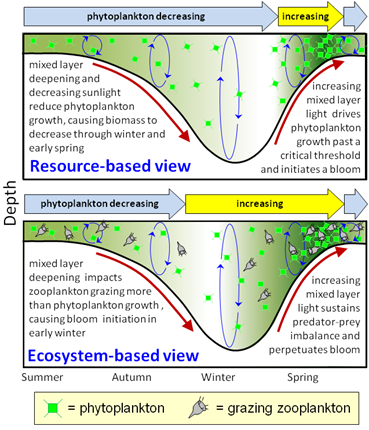
Turbulent storms churn the ocean in summer, adding nutrients to sunlit waters near the surface. This sparks a feeding frenzy each spring that gives rise to massive blooms of phytoplankton. Tiny molecules found inside these microscopic plants harvest vital energy from sunlight through photosynthesis. The natural pigments, called chlorophyll, allow phytoplankton to thrive in Earth's oceans and enable scientists to monitor blooms from space. Satellites reveal the location and abundance of phytoplankton by detecting the amount of chlorophyll present in coastal and open waters—the higher the concentration, the larger the bloom. Observations show blooms typically last until late spring or early summer, when nutrient stocks are in decline and predatory zooplankton start to graze. The visualization on the left immediately below uses NASA SeaWiFS data to map bloom populations.[24]
-
Rivers, such as the Amazon, deposit nutrients from land into South America's tropical ocean waters, leading to thick blooms along the coastline [24]
-
Blooms flourish in a dark plume of nutrient-rich water pouring from the mouth of the Amazon River, as seen by NASA's Aqua satellite.[24]
The NAAMES study conducted between 2015 and 2019 investigated aspects of phytoplankton dynamics in ocean ecosystems, and how such dynamics influence atmospheric aerosols, clouds, and climate. [25]
In France, citizens are requested to report coloured waters through the project PHENOMER.[26] This helps to understand the occurrence of marine blooms.
Wildfires can cause phytoplankton blooms via oceanic deposition of wildfire aerosols.[27]
Harmful algal blooms
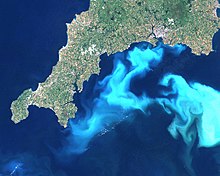
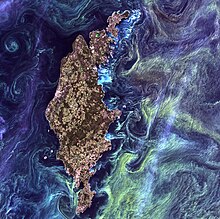
A harmful algal bloom (HAB) is an algal bloom that causes negative impacts to other organisms via production of natural toxins, mechanical damage to other organisms, or by other means. The diversity of these HABs make them even harder to manage, and present many issues, especially to threatened coastal areas.[28] HABs are often associated with large-scale marine mortality events and have been associated with various types of shellfish poisonings.[29] Due to their negative economic and health impacts, HABs are often carefully monitored.[30][31]
HAB has been proved to be harmful to humans. Humans may be exposed to toxic algae by direct consuming seafood containing toxins, swimming or other activities in water, and breathing tiny droplets in the air that contain toxins. [32]
If the HAB event results in a high enough concentration of algae the water may become discoloured or murky, varying in colour from purple to almost pink, normally being red or green. Not all algal blooms are dense enough to cause water discolouration.
See also
- Amnesic shellfish poisoning – Syndrome of shellfish poisoning
- Anatoxin-a – chemical compound
- Chironomus Annularius – A species of nonbiting midges that act as a natural algae control.
- Ciguatera fish poisoning – Foodborne illness
- Dinocyst – dormant cell type of dinoflagellates, often found as fossils
- Dinoflagellate – Unicellular algae with two flagella
- Domoic acid – chemical compound
- Emiliania huxleyi – Unicellular algae responsible for the formation of chalk
- Milky seas effect – Luminous phenomenon in the ocean
- Neurotoxic shellfish poisoning – Syndrome of shellfish poisoning
- Paralytic shellfish poisoning – Syndrome of shellfish poisoning
- Pfiesteria – Genus of single-celled organisms
- Pseudi-nitzschia – Genus of marine planktonic diatoms
- Raphidophyte – Group of aquatic algae
- Saxitoxin – Paralytic shellfish toxin
- Spring bloom – Strong increase in phytoplankton abundance that typically occurs in the early spring
- Thin layers (oceanography)
References
- ^ Foster, Joanna M. (20 November 2013). "Lake Erie Is Dying Again, And Warmer Waters And Wetter Weather Are To Blame". ClimateProgress. Archived from the original on 3 August 2014. Retrieved 3 August 2014.
- ^ Ferris, Robert (26 July 2016). "Why are there so many toxic algae blooms this year". CNBC. Retrieved 27 July 2016.
- ^ a b c d e f Barsanti, Laura; Gualtieri, Paolo (2014). Algae: Anatomy, Biochemistry, And Biotechnology. Boca Raton, FL: CRC Press. p. 1. ISBN 978-1-4398-6733-4.
- ^ a b Smayda, Theodore J. (1997). "What is a bloom? A commentary". Limnology and Oceanography. 42 (5part2): 1132–1136. Bibcode:1997LimOc..42.1132S. doi:10.4319/lo.1997.42.5_part_2.1132. ISSN 1939-5590.
- ^ Tett, P (1987). "The Ecophysiology of Exceptional Blooms". Rapp. P.-v. Reun. Cons. Int. Explor. Mer. 187: 47–60.
- ^ Jonsson, Per R.; Pavia, Henrik; Toth, Gunilla (7 July 2009). "Formation of harmful algal blooms cannot be explained by allelopathic interactions". Proceedings of the National Academy of Sciences of the United States of America. 106 (27): 11177–11182. Bibcode:2009PNAS..10611177J. doi:10.1073/pnas.0900964106. ISSN 0027-8424. PMC 2708709. PMID 19549831.
- ^ Kim, H.G. (1993). "Population cell volume and carbon content in monospecific dinoflagellate blooms". Toxic phytoplankton blooms in the sea. Developments in Marine Biology. Vol. 3. Elsevier. pp. 769–773.
- ^ Parker, M (1987). "Exceptional Plankton Blooms Conclusion of Discussions: Convener's Report". Rapp. P.-v. Reun. Cons. Int. Explor. Mer. 187: 108–114.
- ^ a b Carstensen, Jacob; Henriksen, Peter; Heiskanen, Anna-Stiina (January 2007). "Summer algal blooms in shallow estuaries: Definition, mechanisms, and link to eutrophication". Limnology and Oceanography. 52 (1): 370–384. Bibcode:2007LimOc..52..370C. doi:10.4319/lo.2007.52.1.0370. ISSN 0024-3590. S2CID 15978578.
- ^ Hallegraeff, Gustaaf M.; Anderson, Donald Mark; Cembella, Allan D.; Enevoldsen, Henrik O. (2004). Manual on harmful marine microalgae (Second revised ed.). Paris: UNESCO. ISBN 9231039482. OCLC 493956343.
- ^ Gilbert, Patricia M.; Anderson, Donald M.; Gentien, Patrick; Graneli, Edna; Sellner, Kevin G. (2005). "The Global Complex Phenomena of Harmful Algal Blooms". Oceanography. 8 (2): 130–141.
- ^ Jacoby, Jean M; Collier, Diane C; Welch, Eugene B; Hardy, F Joan; Crayton, Michele (2000). "Environmental factors associated with a toxic bloom of Microcystis aeruginosa". Canadian Journal of Fisheries and Aquatic Sciences. 57 (1): 231–240. doi:10.1139/f99-234. ISSN 0706-652X.
- ^ Liu, Dongyan; Keesing, John K.; Xing, Qianguo; Shi, Ping (1 June 2009). "World's largest macroalgal bloom caused by expansion of seaweed aquaculture in China". Marine Pollution Bulletin. 58 (6): 888–895. doi:10.1016/j.marpolbul.2009.01.013. ISSN 0025-326X. PMID 19261301.
- ^ Hallegraef, G.M. (1993). "A review of harmful algal blooms and their apparent global increase". Phycologia. 32 (2): 79–99. doi:10.2216/i0031-8884-32-2-79.1.
- ^ Diersling, Nancy. "Phytoplankton Blooms: The Basics" (PDF). NOAA FKNMS. Archived (PDF) from the original on 15 October 2011. Retrieved 26 December 2012.
- ^ Hochanadel, Dave (10 December 2010). "Limited amount of total phosphorus actually feeds algae, study finds". Lake Scientist. Retrieved 10 June 2012.
[B]ioavailable phosphorus – phosphorus that can be utilized by plants and bacteria – is only a fraction of the total, according to Michael Brett, a UW engineering professor ...
- ^ Gilbert, P. A.; Dejong, A. L. (1977). "The use of phosphate in detergents and possible replacements for phosphate". Ciba Foundation Symposium. Novartis Foundation Symposia (57): 253–268. doi:10.1002/9780470720387.ch14. ISBN 9780470720387. PMID 249679.
- ^ Higgins, Scott N.; Paterson, Michael J.; Hecky, Robert E.; Schindler, David W.; Venkiteswaran, Jason J.; Findlay, David L. (September 2018). "Biological Nitrogen Fixation Prevents the Response of a Eutrophic Lake to Reduced Loading of Nitrogen: Evidence from a 46-Year Whole-Lake Experiment". Ecosystems. 21 (6): 1088–1100. doi:10.1007/s10021-017-0204-2. ISSN 1432-9840. S2CID 26030685.
- ^ "Storm-triggered, increased supply of sediment-derived phosphorus to the epilimnion in a small freshwater lake". Freshwater Biological Association. 18 November 2014. Archived from the original on 26 October 2019. Retrieved 26 October 2019.
- ^ Lathrop, Richard C.; Carpenter, Stephen R.; Panuska, John C.; Soranno, Patricia A.; Stow, Craig A. (1 May 1998). "Phosphorus loading reductions needed to control blue-green algal blooms in Lake Mendota" (PDF). Canadian Journal of Fisheries and Aquatic Sciences. 55 (5): 1169–1178. doi:10.1139/cjfas-55-5-1169. Retrieved 13 April 2008.[permanent dead link]
- ^ Behrenfeld, M.J. and Boss, E.S. (2018) "Student's tutorial on bloom hypotheses in the context of phytoplankton annual cycles". Global change biology, 24(1): 55–77. doi:10.1111/gcb.13858.
- ^ Behrenfeld, Michael J.; Boss, Emmanuel S. (3 January 2014). "Resurrecting the Ecological Underpinnings of Ocean Plankton Blooms". Annual Review of Marine Science. 6 (1): 167–194. Bibcode:2014ARMS....6..167B. doi:10.1146/annurev-marine-052913-021325. ISSN 1941-1405. PMID 24079309. S2CID 12903662.[permanent dead link]
- ^ NAAMES: Science - Objectives Archived 6 August 2020 at the Wayback Machine Langley Research Center, NASA, Updated: 6 June 2020. Retrieved: 15 June 2020.
- ^ a b c Super Blooms NASA Visualization Explorer, 8 May 2012.
 This article incorporates text from this source, which is in the public domain.
This article incorporates text from this source, which is in the public domain.
- ^ Behrenfeld, Michael J.; Moore, Richard H.; Hostetler, Chris A.; Graff, Jason; Gaube, Peter; Russell, Lynn M.; Chen, Gao; Doney, Scott C.; Giovannoni, Stephen; Liu, Hongyu; Proctor, Christopher (22 March 2019). "The North Atlantic Aerosol and Marine Ecosystem Study (NAAMES): Science Motive and Mission Overview". Frontiers in Marine Science. 6: 122. doi:10.3389/fmars.2019.00122. ISSN 2296-7745.
- ^ "Phenomer". www.phenomer.org. Retrieved 22 February 2022.
- ^ Tang, Weiyi; Llort, Joan; Weis, Jakob; Perron, Morgane M. G.; Basart, Sara; Li, Zuchuan; Sathyendranath, Shubha; Jackson, Thomas; Sanz Rodriguez, Estrella; Proemse, Bernadette C.; Bowie, Andrew R.; Schallenberg, Christina; Strutton, Peter G.; Matear, Richard; Cassar, Nicolas (September 2021). "Widespread phytoplankton blooms triggered by 2019–2020 Australian wildfires". Nature. 597 (7876): 370–375. Bibcode:2021Natur.597..370T. doi:10.1038/s41586-021-03805-8. hdl:2117/351768. ISSN 1476-4687. PMID 34526706. S2CID 237536378.
- ^ Anderson, Donald (January 2004). "Prevention, control and mitigation of harmful algal blooms: multiple approaches to HAB management". ResearchGate. p. 2. Retrieved 26 March 2020.
- ^ "Harmful Algal Blooms: Red Tide: Home". cdc.gov. Archived from the original on 27 August 2009. Retrieved 23 August 2009.
- ^ Florida Fish and Wildlife Research Institute. "Red Tide Current Status Statewide Information". research.myfwc.com. Archived from the original on 22 August 2009. Retrieved 23 August 2009.
- ^ "Red Tide Index". Tpwd.state.tx.us. Retrieved 23 August 2009.
- ^ "Illness and Symptoms: Marine (Saltwater) Algal Blooms | Harmful Algal Blooms | CDC". www.cdc.gov. 30 September 2021. Retrieved 10 January 2022.

![Rivers, such as the Amazon, deposit nutrients from land into South America's tropical ocean waters, leading to thick blooms along the coastline [24]](http://upload.wikimedia.org/wikipedia/commons/thumb/c/c4/Ocean_phytoplankton_bloom_feed_by_the_Amazon_River.jpg/454px-Ocean_phytoplankton_bloom_feed_by_the_Amazon_River.jpg)
![Blooms flourish in a dark plume of nutrient-rich water pouring from the mouth of the Amazon River, as seen by NASA's Aqua satellite.[24]](http://upload.wikimedia.org/wikipedia/commons/thumb/e/ed/Algal_blooms_at_the_mouth_of_the_Amazon_River.jpg/454px-Algal_blooms_at_the_mouth_of_the_Amazon_River.jpg)




